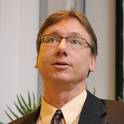
Caloric cooling and heat pumping rely on reversible thermal effects triggered in solids by magnetic, electric or stress fields. In the recent past, there have been several successful demonstrations of using first-order phase transition materials in laboratory cooling devices based on both the giant magnetocaloric and elastocaloric effects. All such materials exhibit non-equilibrium behaviours when driven through phase transformations by corresponding fields. Common wisdom is that non-equilibrium states should be avoided; yet, as we show using a model material exhibiting a giant magnetocaloric effect, non-equilibrium phase-separated states offer a unique opportunity to achieve uncommonly large caloric effects by very small perturbations of the driving field(s).
Available at: http://works.bepress.com/duane_johnson/119/

This is a manuscripts of an article published as Pecharsky, Vitalij K., Jun Cui, and Duane D. Johnson. "(Magneto) caloric refrigeration: is there light at the end of the tunnel?." Phil. Trans. R. Soc. A 374, no. 2074 (2016): 20150305. DOI: 10.1098/rsta.2015.0305. Posted with permission.